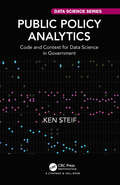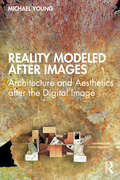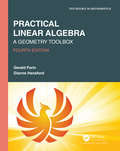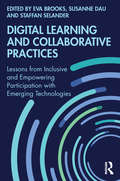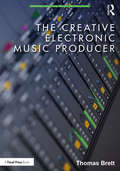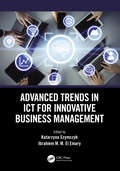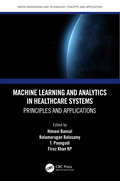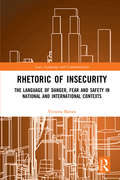- Table View
- List View
Public Policy Analytics: Code and Context for Data Science in Government (Chapman & Hall/CRC Data Science Series)
by Ken SteifPublic Policy Analytics: Code & Context for Data Science in Government teaches readers how to address complex public policy problems with data and analytics using reproducible methods in R. Each of the eight chapters provides a detailed case study, showing readers: how to develop exploratory indicators; understand ‘spatial process’ and develop spatial analytics; how to develop ‘useful’ predictive analytics; how to convey these outputs to non-technical decision-makers through the medium of data visualization; and why, ultimately, data science and ‘Planning’ are one and the same. A graduate-level introduction to data science, this book will appeal to researchers and data scientists at the intersection of data analytics and public policy, as well as readers who wish to understand how algorithms will affect the future of government.
Public Policy Analytics: Code and Context for Data Science in Government (Chapman & Hall/CRC Data Science Series)
by Ken SteifPublic Policy Analytics: Code & Context for Data Science in Government teaches readers how to address complex public policy problems with data and analytics using reproducible methods in R. Each of the eight chapters provides a detailed case study, showing readers: how to develop exploratory indicators; understand ‘spatial process’ and develop spatial analytics; how to develop ‘useful’ predictive analytics; how to convey these outputs to non-technical decision-makers through the medium of data visualization; and why, ultimately, data science and ‘Planning’ are one and the same. A graduate-level introduction to data science, this book will appeal to researchers and data scientists at the intersection of data analytics and public policy, as well as readers who wish to understand how algorithms will affect the future of government.
Reality Modeled After Images: Architecture and Aesthetics after the Digital Image
by Michael YoungReality Modeled After Images: Architecture and Aesthetics after the Digital Image explores architecture’s entanglement with contemporary image culture. It looks closely at how changes produced through technologies of mediation alter disciplinary concepts and produce political effects. Through both historical and contemporary examples, it focuses on how conventions of representation are established, maintained, challenged, and transformed. Critical investigations are conjoined with inquiries into aesthetics and technology in the hope that the tensions between them can aid an exploration into how architectural images are produced, disseminated, and valued; how images alter assumptions regarding the appearances of architecture and the environment.For students and academics in architecture, design and media studies, architectural and art history, and related fields, this book shows how design is impacted and changed by shifts in image culture, representational conventions and technologies.
Reality Modeled After Images: Architecture and Aesthetics after the Digital Image
by Michael YoungReality Modeled After Images: Architecture and Aesthetics after the Digital Image explores architecture’s entanglement with contemporary image culture. It looks closely at how changes produced through technologies of mediation alter disciplinary concepts and produce political effects. Through both historical and contemporary examples, it focuses on how conventions of representation are established, maintained, challenged, and transformed. Critical investigations are conjoined with inquiries into aesthetics and technology in the hope that the tensions between them can aid an exploration into how architectural images are produced, disseminated, and valued; how images alter assumptions regarding the appearances of architecture and the environment.For students and academics in architecture, design and media studies, architectural and art history, and related fields, this book shows how design is impacted and changed by shifts in image culture, representational conventions and technologies.
Practical Linear Algebra: A Geometry Toolbox (Textbooks in Mathematics)
by Gerald Farin Dianne HansfordLinear algebra is growing in importance. 3D entertainment, animations in movies and video games are developed using linear algebra. Animated characters are generated using equations straight out of this book. Linear algebra is used to extract knowledge from the massive amounts of data generated from modern technology. The Fourth Edition of this popular text introduces linear algebra in a comprehensive, geometric, and algorithmic way. The authors start with the fundamentals in 2D and 3D, then move on to higher dimensions, expanding on the fundamentals and introducing new topics, which are necessary for many real-life applications and the development of abstract thought. Applications are introduced to motivate topics. The subtitle, A Geometry Toolbox, hints at the book’s geometric approach, which is supported by many sketches and figures. Furthermore, the book covers applications of triangles, polygons, conics, and curves. Examples demonstrate each topic in action. This practical approach to a linear algebra course, whether through classroom instruction or self-study, is unique to this book. New to the Fourth Edition: Ten new application sections. A new section on change of basis. This concept now appears in several places. Chapters 14-16 on higher dimensions are notably revised. A deeper look at polynomials in the gallery of spaces. Introduces the QR decomposition and its relevance to least squares. Similarity and diagonalization are given more attention, as are eigenfunctions. A longer thread on least squares, running from orthogonal projections to a solution via SVD and the pseudoinverse. More applications for PCA have been added. More examples, exercises, and more on the kernel and general linear spaces. A list of applications has been added in Appendix A. The book gives instructors the option of tailoring the course for the primary interests of their students: mathematics, engineering, science, computer graphics, and geometric modeling.
Practical Linear Algebra: A Geometry Toolbox (Textbooks in Mathematics)
by Gerald Farin Dianne HansfordLinear algebra is growing in importance. 3D entertainment, animations in movies and video games are developed using linear algebra. Animated characters are generated using equations straight out of this book. Linear algebra is used to extract knowledge from the massive amounts of data generated from modern technology. The Fourth Edition of this popular text introduces linear algebra in a comprehensive, geometric, and algorithmic way. The authors start with the fundamentals in 2D and 3D, then move on to higher dimensions, expanding on the fundamentals and introducing new topics, which are necessary for many real-life applications and the development of abstract thought. Applications are introduced to motivate topics. The subtitle, A Geometry Toolbox, hints at the book’s geometric approach, which is supported by many sketches and figures. Furthermore, the book covers applications of triangles, polygons, conics, and curves. Examples demonstrate each topic in action. This practical approach to a linear algebra course, whether through classroom instruction or self-study, is unique to this book. New to the Fourth Edition: Ten new application sections. A new section on change of basis. This concept now appears in several places. Chapters 14-16 on higher dimensions are notably revised. A deeper look at polynomials in the gallery of spaces. Introduces the QR decomposition and its relevance to least squares. Similarity and diagonalization are given more attention, as are eigenfunctions. A longer thread on least squares, running from orthogonal projections to a solution via SVD and the pseudoinverse. More applications for PCA have been added. More examples, exercises, and more on the kernel and general linear spaces. A list of applications has been added in Appendix A. The book gives instructors the option of tailoring the course for the primary interests of their students: mathematics, engineering, science, computer graphics, and geometric modeling.
Digital Learning and Collaborative Practices: Lessons from Inclusive and Empowering Participation with Emerging Technologies
by Eva Brooks Susanne Dau Staffan SelanderDigital Learning and Collaborative Practices offers a comprehensive overview of design-based, technology-enhanced approaches to teaching and learning in virtual settings. Today’s digital communications foster new opportunities for sharing culture and knowledge while also prompting concerns over division, disinformation and surveillance. This book uniquely emphasises playful, collaborative experiences and democratic values in a variety of environments—adaptive, augmented, dialogic, game-based and beyond. Graduate students and researchers of educational technology, the learning sciences and interaction design will discover rich theories, interventions, models and approaches for concretising emerging practices and competencies in digital learning spaces.
Digital Learning and Collaborative Practices: Lessons from Inclusive and Empowering Participation with Emerging Technologies
by Eva Brooks Susanne Dau Staffan SelanderDigital Learning and Collaborative Practices offers a comprehensive overview of design-based, technology-enhanced approaches to teaching and learning in virtual settings. Today’s digital communications foster new opportunities for sharing culture and knowledge while also prompting concerns over division, disinformation and surveillance. This book uniquely emphasises playful, collaborative experiences and democratic values in a variety of environments—adaptive, augmented, dialogic, game-based and beyond. Graduate students and researchers of educational technology, the learning sciences and interaction design will discover rich theories, interventions, models and approaches for concretising emerging practices and competencies in digital learning spaces.
Telecom Extreme Transformation: The Road to a Digital Service Provider
by Kaveh Hushyar Harald Braun Hossein EslambolchiThe extreme transformation from a traditional Communication Service Provider (CSP) to a Digital Service Provider (DSP) status is covered in this book, specifically: Redefinition of the offerings of "connectivity services" to "digital services"; unification of legacy redundant networks into one; Redefinition of the measurements to customer-centric QoE for all digital and connectivity services; the Best-in-Industry processes and practices to ensure a sustainable network performance at a competitively operational efficiency; a Service-over-IP (SoIP) platform to enable the introduction of unified new services with a time-to-market urgency; the regulatory arrangement for content purification, to liberalize CSPs to become DSPs; an architecture for data mining and analytics; and a migration plan from a CSP to a DSP status. The book is recommended for telecom and digital service professionals planning to embark on transformational projects; telecom and technology equipment manufacturers to help with product development for a DSP status; institutional investors to evaluate and establish their investment decisions; telecom management consultants to help with a solid benchmark for transformation engagement; university students, majoring in telecommunication and technology products as a guide for career planning.
Telecom Extreme Transformation: The Road to a Digital Service Provider
by Kaveh Hushyar Harald Braun Hossein EslambolchiThe extreme transformation from a traditional Communication Service Provider (CSP) to a Digital Service Provider (DSP) status is covered in this book, specifically: Redefinition of the offerings of "connectivity services" to "digital services"; unification of legacy redundant networks into one; Redefinition of the measurements to customer-centric QoE for all digital and connectivity services; the Best-in-Industry processes and practices to ensure a sustainable network performance at a competitively operational efficiency; a Service-over-IP (SoIP) platform to enable the introduction of unified new services with a time-to-market urgency; the regulatory arrangement for content purification, to liberalize CSPs to become DSPs; an architecture for data mining and analytics; and a migration plan from a CSP to a DSP status. The book is recommended for telecom and digital service professionals planning to embark on transformational projects; telecom and technology equipment manufacturers to help with product development for a DSP status; institutional investors to evaluate and establish their investment decisions; telecom management consultants to help with a solid benchmark for transformation engagement; university students, majoring in telecommunication and technology products as a guide for career planning.
The Creative Electronic Music Producer (Perspectives on Music Production)
by Thomas BrettThe Creative Electronic Music Producer examines the creative processes of electronic music production, from idea discovery and perception to the power of improvising, editing, effects processing,sound design. Featuring case studies from across the globe on musical systems and workflows used in the production process, this book highlights how to pursue creative breakthroughs through exploration, trial and error tinkering, recombination, and transformation.The Creative Electronic Music Producer maps production's enchanting pathways in a way that will fascinate and inspire students of electronic music production, professionals already working in the industry, and hobbyists.
The Creative Electronic Music Producer (Perspectives on Music Production)
by Thomas BrettThe Creative Electronic Music Producer examines the creative processes of electronic music production, from idea discovery and perception to the power of improvising, editing, effects processing,sound design. Featuring case studies from across the globe on musical systems and workflows used in the production process, this book highlights how to pursue creative breakthroughs through exploration, trial and error tinkering, recombination, and transformation.The Creative Electronic Music Producer maps production's enchanting pathways in a way that will fascinate and inspire students of electronic music production, professionals already working in the industry, and hobbyists.
Handbook of Green Engineering Technologies for Sustainable Smart Cities (Green Engineering and Technology)
by K. Saravanan G. SakthinathanHandbook of Green Engineering Technologies for Sustainable Smart Cities focuses on the complete exploration and presentation of green smart city applications, techniques, and architectural frameworks. It provides detailed coverage of urban sustainability spanning across various engineering disciplines. The book discusses and explores green engineering technologies for smart cities and covers various engineering disciplines and environmental science. It emphasizes techniques, application frameworks, tools, and case studies. All chapters play a part in the evolution of sustainable green smart cities and present how to solve environmental issues by applying modern industrial IoT solutions. This book will benefit researchers, smart city practitioners, academicians, university students, and policy makers.
Handbook of Green Engineering Technologies for Sustainable Smart Cities (Green Engineering and Technology)
by K. Saravanan; G. SakthinathanHandbook of Green Engineering Technologies for Sustainable Smart Cities focuses on the complete exploration and presentation of green smart city applications, techniques, and architectural frameworks. It provides detailed coverage of urban sustainability spanning across various engineering disciplines. The book discusses and explores green engineering technologies for smart cities and covers various engineering disciplines and environmental science. It emphasizes techniques, application frameworks, tools, and case studies. All chapters play a part in the evolution of sustainable green smart cities and present how to solve environmental issues by applying modern industrial IoT solutions. This book will benefit researchers, smart city practitioners, academicians, university students, and policy makers.
Crime Science and Digital Forensics: A Holistic View
by Anthony C. Ijeh Kevin CurranThis volume is a collation of articles on counter forensics practices and digital investigative methods from the perspective of crime science. The book also shares alternative dialogue on information security techniques used to protect data from unauthorised access and manipulation. Scandals such as those at OPCW and Gatwick Airport have reinforced the importance of crime science and the need to take proactive measures rather than a wait and see approach currently used by many organisations. This book proposes a new approach in dealing with cybercrime and unsociable behavior involving remote technologies using a combination of evidence-based disciplines in order to enhance cybersecurity and authorised controls. It starts by providing a rationale for combining selected disciplines to enhance cybersecurity by discussing relevant theories and highlighting the features that strengthen privacy when mixed. The essence of a holistic model is brought about by the challenge facing digital forensic professionals within environments where tested investigative practices are unable to provide satisfactory evidence and security. This book will be of interest to students, digital forensic and cyber security practitioners and policy makers. It marks a new route in the study of combined disciplines to tackle cybercrime using digital investigations and crime science.
Crime Science and Digital Forensics: A Holistic View
by Anthony C. IjehThis volume is a collation of articles on counter forensics practices and digital investigative methods from the perspective of crime science. The book also shares alternative dialogue on information security techniques used to protect data from unauthorised access and manipulation. Scandals such as those at OPCW and Gatwick Airport have reinforced the importance of crime science and the need to take proactive measures rather than a wait and see approach currently used by many organisations. This book proposes a new approach in dealing with cybercrime and unsociable behavior involving remote technologies using a combination of evidence-based disciplines in order to enhance cybersecurity and authorised controls. It starts by providing a rationale for combining selected disciplines to enhance cybersecurity by discussing relevant theories and highlighting the features that strengthen privacy when mixed. The essence of a holistic model is brought about by the challenge facing digital forensic professionals within environments where tested investigative practices are unable to provide satisfactory evidence and security. This book will be of interest to students, digital forensic and cyber security practitioners and policy makers. It marks a new route in the study of combined disciplines to tackle cybercrime using digital investigations and crime science.
Advanced Trends in ICT for Innovative Business Management
by Katarzyna Szymczyk Ibrahiem M. M. El EmaryThis book contains a collection of scientific chapters addressing the emerging trends in IT and telecommunications, as well as the issues that accompany them in business. It addresses issues in cyber applications, ICT solutions and innovative cyber know-how, and demonstrates how high-tech IT communications resources can be used to improve business production, sales and service strategies, supply chains and logistics. The book is based on articles from ICCMIT’20, extending their approach to specific chapters. The chapters cover issues such as financial management, technological upgrades, Industry 4.0 and the trend towards sustainable development. It utilizes examples of technologically advanced enterprises developing under Industry 4.0 assumptions at the stage of digital transformation, which integrate digital technologies and business processes. In addition, this book discusses issues related to cyber risk management and the implementation of a number of safeguards for digitized enterprises. Enterprises that orient themselves towards technological innovations find that they can reach customers faster, are more effectively managed and can achieve a competitive advantage over other businesses. This book will be a great aid to professionals in such companies, both in IT departments and in the management team.
Advanced Trends in ICT for Innovative Business Management
by Katarzyna Szymczyk Ibrahiem M. M. El EmaryThis book contains a collection of scientific chapters addressing the emerging trends in IT and telecommunications, as well as the issues that accompany them in business. It addresses issues in cyber applications, ICT solutions and innovative cyber know-how, and demonstrates how high-tech IT communications resources can be used to improve business production, sales and service strategies, supply chains and logistics. The book is based on articles from ICCMIT’20, extending their approach to specific chapters. The chapters cover issues such as financial management, technological upgrades, Industry 4.0 and the trend towards sustainable development. It utilizes examples of technologically advanced enterprises developing under Industry 4.0 assumptions at the stage of digital transformation, which integrate digital technologies and business processes. In addition, this book discusses issues related to cyber risk management and the implementation of a number of safeguards for digitized enterprises. Enterprises that orient themselves towards technological innovations find that they can reach customers faster, are more effectively managed and can achieve a competitive advantage over other businesses. This book will be a great aid to professionals in such companies, both in IT departments and in the management team.
Machine Learning and Analytics in Healthcare Systems: Principles and Applications (Green Engineering and Technology)
by Himani Bansal Balamurugan Balusamy T. Poongodi Firoz Khan KpThis book provides applications of machine learning in healthcare systems and seeks to close the gap between engineering and medicine. It will combine the design and problem-solving skills of engineering with health sciences, in order to advance healthcare treatment. The book will include areas such as diagnosis, monitoring, and therapy. The book will provide real-world case studies, gives a detailed exploration of applications in healthcare systems, offers multiple perspectives on a variety of disciplines, while also letting the reader know how to avoid some of the consequences of old methods with data sharing. The book can be used as a reference for practitioners, researchers and for students at basic and intermediary levels in Computer Science, Electronics and Communications.
Machine Learning and Analytics in Healthcare Systems: Principles and Applications (Green Engineering and Technology)
by Himani Bansal, Balamurugan Balusamy, T. Poongodi, and Firoz Khan KPThis book provides applications of machine learning in healthcare systems and seeks to close the gap between engineering and medicine. It will combine the design and problem-solving skills of engineering with health sciences, in order to advance healthcare treatment. The book will include areas such as diagnosis, monitoring, and therapy. The book will provide real-world case studies, gives a detailed exploration of applications in healthcare systems, offers multiple perspectives on a variety of disciplines, while also letting the reader know how to avoid some of the consequences of old methods with data sharing. The book can be used as a reference for practitioners, researchers and for students at basic and intermediary levels in Computer Science, Electronics and Communications.
Deep Learning for Biomedical Applications (Artificial Intelligence (AI): Elementary to Advanced Practices)
by Utku Kose Omer Deperlioglu D. Jude HemanthThis book is a detailed reference on biomedical applications using Deep Learning. Because Deep Learning is an important actor shaping the future of Artificial Intelligence, its specific and innovative solutions for both medical and biomedical are very critical. This book provides a recent view of research works on essential, and advanced topics. The book offers detailed information on the application of Deep Learning for solving biomedical problems. It focuses on different types of data (i.e. raw data, signal-time series, medical images) to enable readers to understand the effectiveness and the potential. It includes topics such as disease diagnosis, image processing perspectives, and even genomics. It takes the reader through different sides of Deep Learning oriented solutions. The specific and innovative solutions covered in this book for both medical and biomedical applications are critical to scientists, researchers, practitioners, professionals, and educations who are working in the context of the topics.
Deep Learning for Biomedical Applications (Artificial Intelligence (AI): Elementary to Advanced Practices)
by Utku Kose Omer Deperlioglu D. Jude HemanthThis book is a detailed reference on biomedical applications using Deep Learning. Because Deep Learning is an important actor shaping the future of Artificial Intelligence, its specific and innovative solutions for both medical and biomedical are very critical. This book provides a recent view of research works on essential, and advanced topics. The book offers detailed information on the application of Deep Learning for solving biomedical problems. It focuses on different types of data (i.e. raw data, signal-time series, medical images) to enable readers to understand the effectiveness and the potential. It includes topics such as disease diagnosis, image processing perspectives, and even genomics. It takes the reader through different sides of Deep Learning oriented solutions. The specific and innovative solutions covered in this book for both medical and biomedical applications are critical to scientists, researchers, practitioners, professionals, and educations who are working in the context of the topics.
Rhetoric of InSecurity: The Language of Danger, Fear and Safety in National and International Contexts (Law, Language and Communication)
by Victoria BainesThis book demands that we question what we are told about security, using tools we have had for thousands of years. The work considers the history of security rhetoric in a number of distinct but related contexts, including the United States’ security strategy, the "war" on Big Tech, and current concerns such as cybersecurity. Focusing on the language of security discourse, it draws common threads from the ancient world to the present day and the near future. The book grounds recent comparisons of Donald Trump to the Emperor Nero in a linguistic evidence base. It examines the potential impact on society of policy-makers’ emphasis on the novelty of cybercrime, their likening of the internet to the Wild West, and their claims that criminals have "gone dark". It questions governments’ descriptions of technology companies in words normally reserved for terrorists, and asks who might benefit. Interdisciplinary in approach, the book builds on existing literature in the Humanities and Social Sciences, most notably studies on rhetoric in Greco-Roman texts, and on the articulation of security concerns in law, international relations, and public policy contexts. It adds value to this body of research by offering new points of comparison, and a fresh but tried and tested way of looking at problems that are often presented as unprecedented. It will be essential to legal and policy practitioners, students of Law, Politics, Media, and Classics, and all those interested in employing critical thinking.
Rhetoric of InSecurity: The Language of Danger, Fear and Safety in National and International Contexts (Law, Language and Communication)
by Victoria BainesThis book demands that we question what we are told about security, using tools we have had for thousands of years. The work considers the history of security rhetoric in a number of distinct but related contexts, including the United States’ security strategy, the "war" on Big Tech, and current concerns such as cybersecurity. Focusing on the language of security discourse, it draws common threads from the ancient world to the present day and the near future. The book grounds recent comparisons of Donald Trump to the Emperor Nero in a linguistic evidence base. It examines the potential impact on society of policy-makers’ emphasis on the novelty of cybercrime, their likening of the internet to the Wild West, and their claims that criminals have "gone dark". It questions governments’ descriptions of technology companies in words normally reserved for terrorists, and asks who might benefit. Interdisciplinary in approach, the book builds on existing literature in the Humanities and Social Sciences, most notably studies on rhetoric in Greco-Roman texts, and on the articulation of security concerns in law, international relations, and public policy contexts. It adds value to this body of research by offering new points of comparison, and a fresh but tried and tested way of looking at problems that are often presented as unprecedented. It will be essential to legal and policy practitioners, students of Law, Politics, Media, and Classics, and all those interested in employing critical thinking.
Applied Soft Computing: Techniques and Applications
by Samarjeet Borah Ranjit PanigrahiThis new volume explores a variety of modern techniques that deal with estimated models and give resolutions to complex real-life issues. Soft computing has played a crucial role not only with theoretical paradigms but is also popular for its pivotal role for designing a large variety of expert systems and artificial intelligence-based applications. Involving the concepts and practices of soft computing in conjunction with other frontier research domains, this book begins with the basics and goes on to explore a variety of modern applications of soft computing in areas such as approximate reasoning, artificial neural networks, Bayesian networks, big data analytics, bioinformatics, cloud computing, control systems, data mining, functional approximation, fuzzy logic, genetic and evolutionary algorithms, hybrid models, machine learning, metaheuristics, neuro fuzzy system, optimization, randomized searches, and swarm intelligence. This book will be helpful to a wide range of readers who wish to learn applications of soft computing approaches. It will be useful for academicians, researchers, students, and machine learning experts who use soft computing techniques and algorithms to develop cutting-edge artificial intelligence-based applications.
